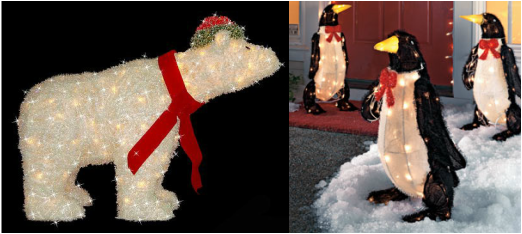|
No, it has nothing to do with the "sweet science" of pugilism. And how the sport of boxing was given that moniker is a whole 'nother post. And it's not about returning those unwanted gifts. Boxing Day, which is celebrated in Great Britain and most of the Commonwealth nations on December 26th, apparently got its name from the practice of the gentry giving their servants boxes of celebration leftovers and other small gifts on this day. The servants would have to work on December 25th but would then be given the following day off, along with their presents.
An alternative explanation is that the church alms boxes where parishioners would deposit coins for the poor would be opened on this day and distributed to the destitute of the parish. As years passed, the custom of giving small gifts grew to include anyone who had rendered a service over the course of the year. December 26th is also the Feast of Saint Stephen, the first Christian martyr. Saint Stephen was one of the seven original deacons of the Christian Church who were ordained by the Apostles to care for widows and the poverty-stricken. For the success of his preaching and his religious devotion, St. Stephen was stoned to death by a mob outside the city of Jerusalem. As he died, he begged God not to punish his killers.
0 Comments
Here’s a Christmas Smackdown to enjoy while you await the arrival of the big jolly elf... Category: Christmas Icons Rudolph vs. Frosty A four way match-up between St. Nicholas vs. Santa Claus vs. Kris Kringle vs. Pere Noel Category: Music First up, a three-way match-up for the most intolerable version (or best version, your choice) of “Last Christmas:” George Michael vs. Taylor Swift vs. Glee cast Most Depressing Christmas song: The Christmas Shoes vs. A Soldier’s Silent Night Category: Christmas theatre cash cows The Nutcracker ballet vs. A Christmas Carol Category: TV Specials (as they were called back in the day) How the Grinch Stole Christmas vs. A Charlie Brown Christmas Category: Classic Christmas Movies It’s a Wonderful Life (an angel gets its wings) vs. A Christmas Story (you’ll shoot your eye out) Category: Flora Holly vs. Ivy Evergreen tree (real) vs. Evergreen tree (artificial) Category: Food Fruitcake vs. Anything Sugar cookies vs. gingerbread cookies Candy canes vs. peppermint bark Category: Decorations Christmas lights vs. Inflatables Polar bears vs. Penguins “Themed” Christmas trees vs. any ornament you happen to like plus the home- or school-made masterpieces Category: Preferred locations for the “stuffer” gifts Stockings vs. Shoes Category: Anticipation Christmas Eve vs. New Year’s Eve Category: The Morning After
As those who celebrate Christmas (particularly in the United States) rush to and fro in mad pursuit of last minute gifts and stocking stuffers, clogging roads and parking lots, we can pause a moment to consider some interesting precursors to Christmas revelry... and compare these peculiar rites to our own...
Roman pagans had the holiday of Saturnalia, a weeklong period of lawlessness celebrated between December 17-25. During the festival period, courts were closed, and Roman law dictated that no one could be punished for damaging property or injuring people. Opening ceremonies included the selection by Roman auhorities of an enemy of the Roman people who was known as the Lord of Misrule. Each community selected a victim whom they forced to indulge in food and other physical pleasures throughout the celebration. (Sounds like a fun job, doesn't it? Read on.) At the festival’s end, Roman authorities believed they were destroying the forces of darkness by sacrificing this innocent man or woman. In addition to human sacrifice, the Greek poet and historian Lucian, in his description of the holiday, mentions these customs: widespread intoxication; going from house to house while singing naked (the origins of here we come, a-wassailing??); rape and other sexual license; and consuming human-shaped biscuits! Presumably this festival contributed to the decline and fall of the Roman Empire... The Winter Solstice, which is also known as Yule, is one of the oldest pagan winter celebrations. The seasons and weather were extremely important to ancient people, who, being hunter/gatherers, spent the majority of their time outdoors. Understandably, these cultures has great reverence for, and even worshipped the sun. (Those of us living in the northern climes have a little bit of this pagan spirit still beating within, as we go to work in the dark and come home in the dark, checking Tom Skilling's weather page in the Chicago Tribune, anxiously watching as the sunrise and sunset times slooooowwwwlly start to move farther apart again!) The Norsemen of Northern Europe viewed the sun as a wheel that changed the seasons. It was from the word for this wheel, houl, that the word "yule" is thought to be derived. At mid-winter the Norsemen lit bonfires, told stories and drank sweet ale. (Sound familiar? Substitute a wide-screen TV, Big Bang Theory or Sunday football and bottles of Bud Light and you've flashed forward to the 21st Century.) In Britain, the winter solstice was celebrated on the shortest day of the year (usually December 21st) long before the arrival of Christianity. Oak trees were sacred in the Celtic culture and the winter fruit of the mistletoe which grew on the oak was a symbol of life in the dark winter months. The Druid priests would cut the mistletoe and give it as a blessing. The Druids also began the tradition of the yule log. The Celts thought that the sun stood still for twelve days in the middle of winter (imagine that! -- seems like longer than 12 days to me!) and during this time a log was lit to conquer the darkness, banish evil spirits and bring luck for the coming year. If you live in Wheaton, Illinois, you will recognize the above as the central slogan for the city's annual holiday celebrations. And with good reason. Charles Dickens wrote no less than five novels centered around the Christmas season! He started off in 1843 with the first and most enduring of his Christmas tales, A Christmas Carol, which is now known as the annual Christmas chestnut or cash cow, particularly among theatre groups and their patrons. But did you know that this beloved story, which sends a message that cuts through the materialistic trappings of the season and gets to the heart and soul of the holidays, was actually written as the result of the author's desperate need of money. In the fall of 1843 Dickens and his wife were expecting their fifth child. Requests for money from his extended family, a large mortgage on his Devonshire Terrace home, and lagging sales from the monthly installments of his latest novel, Martin Chuzzlewit, had left Dickens seriously short of cash.  The idea for the story came during a trip Dickens took to Manchester, England to give a speech in support the Athenaeum, a school which provided adult education for factory workers. This experience of championing education as a remedy for crime and poverty, along with a recent visit to the Field Lane Ragged School, a night school for those in abject poverty, made Dickens resolve to "strike a sledge hammer blow" for the poor. At odds with his publishers, Dickens paid for the production cost of the book himself (yes, he self-published!) and insisted on a lavish design that included a gold-stamped cover and four hand-colored etchings. He also set the price at 5 shillings so that the book would be affordable to nearly everyone. The book was published the week before Christmas and became an instant hit. And the rest is history... and annual revivals at the Goodman Theatre.  Dickens published four other Christmas books, none of which achieved the same popularity as A Christmas Carol, but each has its own singular charms. The Chimes, published in 1844, tells the tale of Trotty Veck, a poor ticket porter, whose viewpoint is changed from despair to hope by the spirits of the chimes on New Year's Eve. The Chimes is a bit more topical than A Christmas Carol, referencing social problems more specific to the 1840s. As such, it has lost some of its relevance to today's audience. The Cricket on the Hearth, published in 1845, centers on John and Dot Peerybingle, whose marriage is compromised by its May-December nature. Confronted with Dot's possible infidelity, John consults the spirit of the Cricket on the Hearth, whose chirping supposedly brings good luck. The cricket reassures John that all will be well. The misunderstanding is resolved and the couple's happiness restored.  In 1846, Dickens brought forth The Battle of Life, which was the least successful of his Christmas stories. In 1848, he wrote his final Christmas tale, The Haunted Man and the Ghost's Bargain, the story of Mr. Redlaw, a chemistry professor who is tormented by painful memories. He is visited on Christmas Eve by a phantom, his doppelganger, who bestows the gift of forgetting these memories. The catch is that others who come into contact with the professor also lose remembrance of past hurts and sorrows. Redlaw passes on this gift to members of the Swidger family. For some this might seem a good thing, but for others, whose present happiness is based on remembrance of the past, it is a bitter pill. In the end, the gift is reversed by benevolent nature of Milly Swidger, whose raw memories of her lost child are the source of her kindness. For Dickens, Christmas was far more ghostly than any Halloween... |
AuthorTo find out more about me, click on the Not Your Average Jo tab. Archives
February 2024
Categories
All
|










 RSS Feed
RSS Feed